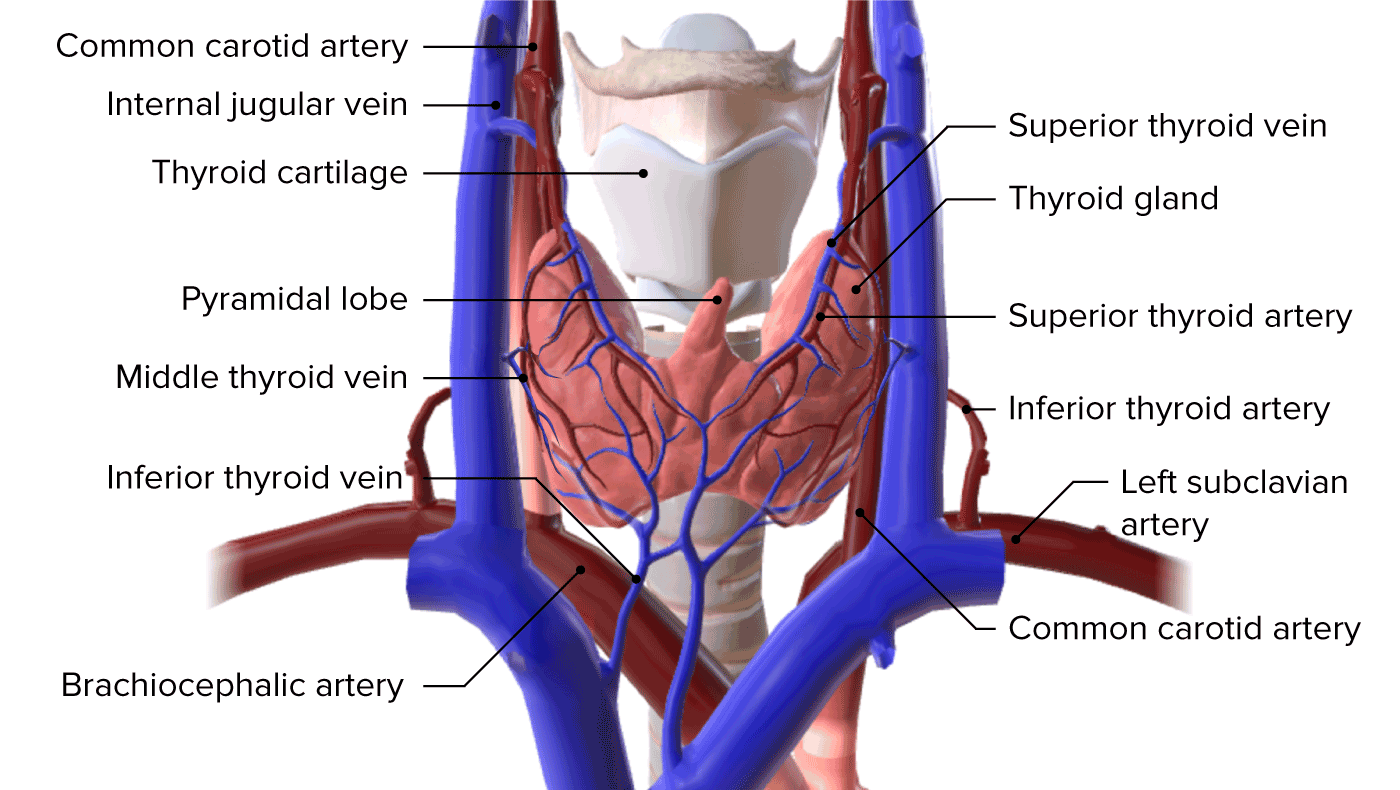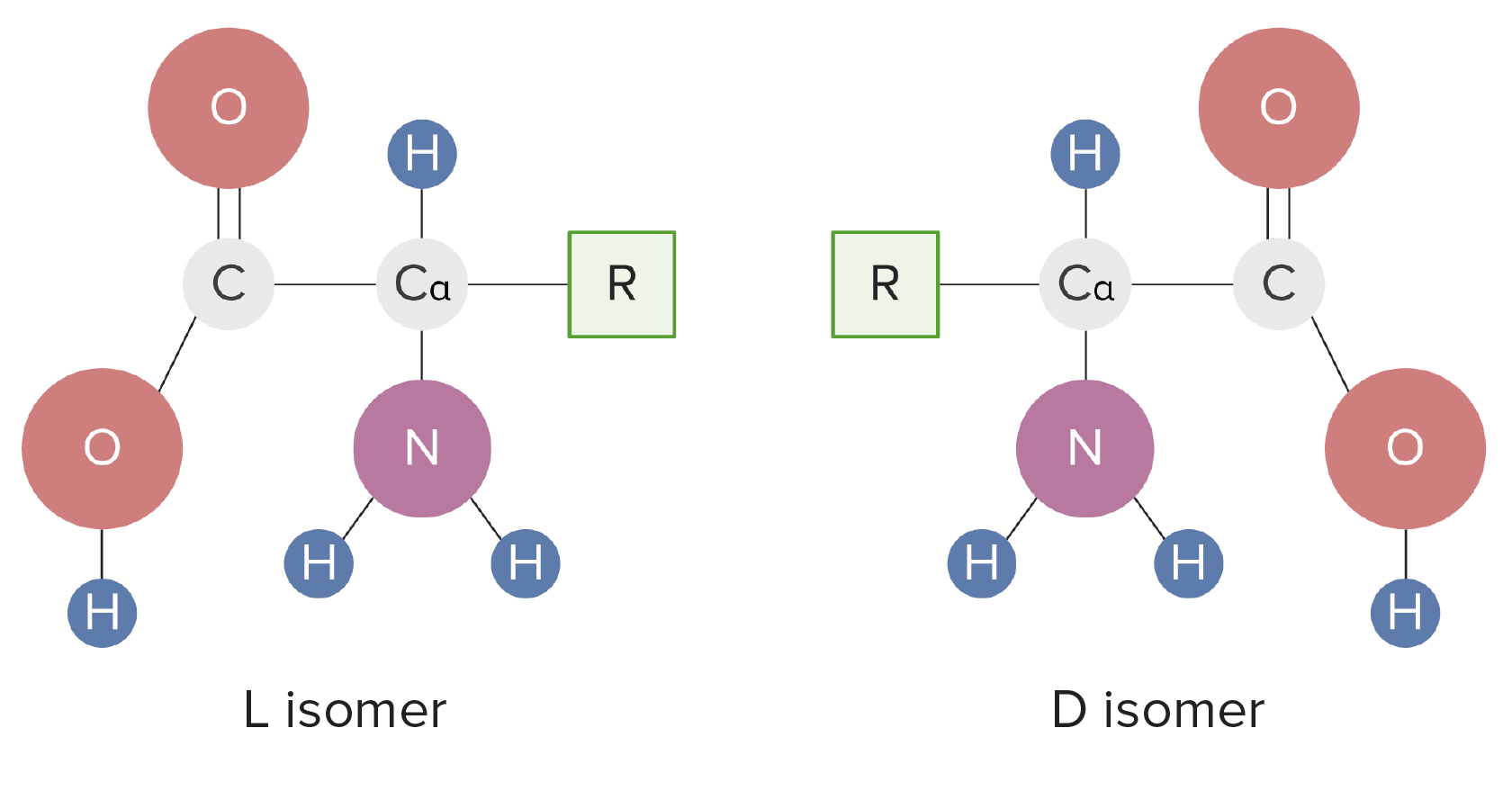Playlist
Show Playlist
Hide Playlist
Tyrosine: Precursor of Thyroid Hormones
-
Slides AminoAcidMetabolism Biochemistry.pdf
-
Reference List Biochemistry.pdf
-
Download Lecture Overview
00:02 Now, tyrosine is also a precursor of the thyroid hormones. 00:06 And this is an interesting set of reactions that occur in the cells of our thyroid gland. 00:11 I'm going to step you through the process and we'll see what happens here. 00:15 So thyroglobulin is a protein that's necessary for making the thyroid hormones. 00:20 It literally provides a substrate on which the individual thyroid hormones are synthesized as we can see here. 00:27 Thyroglobulin synthesis begins in the endoplasmic reticulum. 00:31 And after it has been made, it is excreted out of the endoplasmic reticulum out of the cell into the extracellular space. 00:39 And that's the process you see with those pink arrows moving to the left. 00:43 Thyroglobulins serve as a substrate because sticking off of it are the precursors of what will become the thyroid hormones. 00:51 Those are those little hexagonal structures that you can see by the secreted protein on the left. 00:58 The export from the cell, as I said, releases the thyroglobulin out into the extracellular space. 01:04 So, the synthesis of thyroid hormone is not occurring inside of a cell, it's actually outside the cell where this process occurs. 01:11 Critical for making the thyroid hormones is the ion iodide. 01:16 So, iodide is important for the synthesis for the thyroid hormones. 01:21 Iodide is found in the bloodstream and has to be moved out of the bloodstream into the cell and then ultimately into that extracellular space where it can be joined with the precursors on the thyroglobulin. 01:33 We see that process happening in this set of reactions. 01:36 That is first of all the iodide in the blood is grabbed by the sodium-iodide symporter which moves both ions into the cell. 01:45 We see that happening. 01:47 After iodide has gotten into the cell, it's then transported out of the cell by another transporter moving everything to the left. 01:54 This gets the iodide out into the extracellular space as we can see. 01:58 And the iodide then combines with the precursors that are attached to the thyroglobulin to make the thyroid hormones. 02:05 We see this iodination process occurring right here. 02:08 And then after the iodides have been put onto the individual thyroid hormone precursors, that precursor complex with the thyroglobulin is moved back into the cell. 02:20 Now, the thyroglobulin at the point is broken down. 02:22 The thyroglobulin is no longer needed and that's happening in the next step as we can see here. 02:27 And finally, the thyroid hormones are then moved out of the cell and into the bloodstream where they're used by the rest of the body. 02:35 Now, the thyroid hormones that I was just describing are shown on the screen here. 02:38 They're known as T3 or triiodothyronine or T4, thyroxine. 02:44 T3 is actually the more active form of the thyroid hormones but T4 is the more abundant form. 02:51 T4 is converted into T3 by enzymes known as deiodinases. 02:55 And by the way, the 3s and 4s describe the number of iodines that are in each of this molecules. 03:01 We see the difference being that T4 has four and T3 has three. 03:05 Now an interesting side of that about the deiodinases is that all the ones that are known, all contain that very rare amino acid selenium, saying that amino selenium has some important function involving the removal of iodine from these molecules. 03:20 Now, tyrosine metabolism is also linked to some other molecules that we've heard of and know of. 03:25 One of these is melanin. 03:27 Melanin is known of course for coloring our skin and it's produced by oxidizing and polymerizing tyrosine as we can see here. 03:36 Now, melanin has a very complicated structure. 03:39 We're only looking at a part of a melanin molecule in the structure here. 03:43 We see places where it says additional polymerization and that means more of these molecules can be attached at the places where those arrows actually extend out. 03:52 The tyrosine unit or one tyrosine unit building melanin is shown in the green box. 03:58 The arrows of course pointing to places where additional polymerization is occurring. 04:04 Another molecule made from tyrosine is benzoquinone, a very important part of coenzyme Q. 04:10 Coenzyme Q is essential for the process of electron transport and energy generation. 04:16 We can see the structure of benzoquinone at the bottom and we see also the part that comes from tyrosine. 04:24 Now, tyrosine metabolism as we've seen is a little complicated that leads to a lot of different things. 04:29 Just like the breakdown of phenylalanine was important for healthy cells, so too is the proper breakdown of tyrosine. 04:38 If tyrosine breakdown is interrupted by, for example, the lack of enzymes needed to go through the whole process, then there would be problems that arise. 04:47 There are four types of tyrosinemias that arise. 04:51 Now tyrosinemia arises because the concentration of tyrosine accumulates because it is not being broken down properly. 04:58 We see the breakdown process for tyrosine in the box on the right. 05:02 There is a set of five different steps that are involved in getting from tyrosine to fumurate and acetoacetate. 05:09 Now, the types of tyrosinemia that occur relate to different enzymes that are deficient in this pathway. 05:17 The type I tyrosinemia that I've highlighted here, it results from the lack of the enzyme that converts the very last reaction as you can see. 05:27 Whenever we are lacking an enzyme in a metabolic pathway, that means that the molecules that preceded will accumulate. 05:35 So in this case not only will tyrosine accumulate but so will the other four precursors; beta-hydroxyphenylpyruvate, homogentisate and the other molecules that you can see. 05:46 Type II tyrosinemia arises from a deficiency of the very first enzyme. 05:51 This enzyme will result in the accumulation only of tyrosine. 05:55 Now, we could imagine that we can distinguish these diseases by the fact that different molecules are accumulating and they may have different consequences as a result. 06:04 So, type II tyrosinemia arises from other deficiencies of the enzyme tyrosine transaminase as you can see. 06:11 Type III tyrosinemia arises from a deficiency of the next enzyme in the pathway. 06:16 So, again we see accumulation of the two precursors prior to that. 06:20 And finally alcaptonuria, which is also known as black urine disease, arises from a deficiency of the third enzyme. 06:26 So, any of these enzymes deficient cause some problems for other persons who has those. 06:32 Now, the treatments for both the tyrosinemias as well as the phenylketonurias can be handled by restricting the amount of tyrosine and phenylalanine that a person gets in their diet. 06:43 A more severe way that deals with this is by having a liver transplant.
About the Lecture
The lecture Tyrosine: Precursor of Thyroid Hormones by Kevin Ahern, PhD is from the course Amino Acid Metabolism. It contains the following chapters:
- Tyrosine is a Precursor of Thyroid Hormones
- Tyrosine Metabolism
Included Quiz Questions
Which of the following is true regarding thyroid hormones?
- Thyroid hormones include thyroxine and triiodothyronine.
- They are synthesized within the thyroid cells.
- They are made from thyroglobulin, a precursor derived from glutamate.
- They are derived from the breakdown of carbohydrates.
- Thyromodulin is necessary for the synthesis of thyroid hormones.
Which of the following is true regarding thyroid hormone metabolism? Select all that apply.
- All deiodinases contain selenium.
- All thyroid hormones contain zinc.
- Thyroxine is the most active form.
- Triiodothyronine, with three iodines, is the most active form.
- Iodide ions are imported into thyroid cells from the bloodstream.
What is true regarding tyrosine catabolism dysfunction? Select all that apply.
- It is a factor in phenylketonuria.
- It can be managed by decreasing the intake of leucine.
- There are only two types of tyrosinemias.
- It is treated by reducing the intake of phenylalanine and tyrosine.
- It can result in black urine disease.
Which amino acid is the main precursor of thyroid hormones?
- Tyrosine
- Phenylalanine
- Methionine
- Selenocysteine
- Lysine
Which enzyme converts thyroxine into triiodothyronine?
- Deiodinase
- Tyrosine transaminase
- Aromatic acid decarboxylase
- Dopamine-β-hydroxylase
- 4-fumaryl acetoacetase
Which of the following statements is NOT true?
- Alkaptonuria is a rare inherited genetic disorder in which the body breaks down tyrosine at very rapid rates and leads to the accumulation of fumarate and acetoacetate in the body.
- Thyroglobulin protein participates in the synthesis of T4 and T3 hormones in the thyroid gland.
- The treatment of tyrosinemias and phenylketonuria involves the restriction of intake of amounts of tyrosine and phenylalanine in the individual’s diet.
- Iodide ions, essential for the production of thyroid hormones, are grabbed from the blood and transported into the thyroid follicular cell via sodium-iodide symport.
- There are two types of iodine-containing thyroid hormones: triiodothyronine (T3) and thyroxine (T4).
Which of the following pairs is not correctly associated?
- Phenylketonuria—4-fumarylacetoacetase deficiency
- Tyrosinemia II—tyrosine transaminase deficiency
- Tyrosinemia I—4-fumarylacetoacetase deficiency
- Tyrosinemia III—p-hydroxyphenylpyruvate dioxygenase deficiency
- Alkaptonuria—homogentisate 1,2-dioxidase deficiency
Customer reviews
5,0 of 5 stars
| 5 Stars |
|
5 |
| 4 Stars |
|
0 |
| 3 Stars |
|
0 |
| 2 Stars |
|
0 |
| 1 Star |
|
0 |






